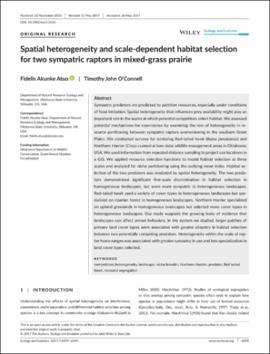| dc.contributor.author | Atuo, Fidelis A. | |
| dc.contributor.author | O'Connell, Timothy J. | |
| dc.date.accessioned | 2019-08-22T17:51:02Z | |
| dc.date.available | 2019-08-22T17:51:02Z | |
| dc.date.issued | 2017-07-15 | |
| dc.identifier | oksd_atuo_spatialheteroge_2017-07-15 | |
| dc.identifier.citation | Atuo, F. A., & O'Connell, T. J. (2017). Spatial heterogeneity and scale-dependent habitat selection for two sympatric raptors in mixed-grass prairie. Ecology and Evolution, 7(16), 6559-6569. https://doi.org/10.1002/ece3.3182 | |
| dc.identifier.uri | https://hdl.handle.net/11244/321262 | |
| dc.description.abstract | Sympatric predators are predicted to partition resources, especially under conditions of food limitation. Spatial heterogeneity that influences prey availability might play an important role in the scales at which potential competitors select habitat. We assessed potential mechanisms for coexistence by examining the role of heterogeneity in resource partitioning between sympatric raptors overwintering in the southern Great Plains. We conducted surveys for wintering Red-tailed hawk (Buteo jamaicensis) and Northern Harrier (Circus cyanea) at two state wildlife management areas in Oklahoma, USA. We used information from repeated distance sampling to project use locations in a GIS. We applied resource selection functions to model habitat selection at three scales and analyzed for niche partitioning using the outlying mean index. Habitat selection of the two predators was mediated by spatial heterogeneity. The two predators demonstrated significant fine-scale discrimination in habitat selection in homogeneous landscapes, but were more sympatric in heterogeneous landscapes. Red-tailed hawk used a variety of cover types in heterogeneous landscapes but specialized on riparian forest in homogeneous landscapes. Northern Harrier specialized on upland grasslands in homogeneous landscapes but selected more cover types in heterogeneous landscapes. Our study supports the growing body of evidence that landscapes can affect animal behaviors. In the system we studied, larger patches of primary land cover types were associated with greater allopatry in habitat selection between two potentially competing predators. Heterogeneity within the scale of raptor home ranges was associated with greater sympatry in use and less specialization in land cover types selected. | |
| dc.format | application/pdf | |
| dc.language | en_US | |
| dc.publisher | Wiley Open Access | |
| dc.rights | This material has been previously published. In the Oklahoma State University Library's institutional repository this version is made available through the open access principles and the terms of agreement/consent between the author(s) and the publisher. The permission policy on the use, reproduction or distribution of the material falls under fair use for educational, scholarship, and research purposes. Contact Digital Resources and Discovery Services at lib-dls@okstate.edu or 405-744-9161 for further information. | |
| dc.title | Spatial heterogeneity and scale-dependent habitat selection for two sympatric raptors in mixed-grass prairie | |
| osu.filename | oksd_atuo_spatialheteroge_2017-07-15.pdf | |
| dc.description.peerreview | Peer reviewed | |
| dc.identifier.doi | 10.1002/ece3.3182 | |
| dc.description.department | Natural Resource Ecology and Management | |
| dc.type.genre | Article | |
| dc.type.material | Text | |
| dc.subject.keywords | competition | |
| dc.subject.keywords | heterogeneity | |
| dc.subject.keywords | landscape | |
| dc.subject.keywords | niche breadth | |
| dc.subject.keywords | northern harrier | |
| dc.subject.keywords | predator | |
| dc.subject.keywords | red-tailed hawk | |
| dc.subject.keywords | resource segregation | |
